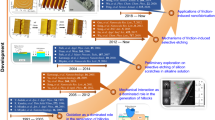Abstract
A novel multi-probe micro-fabrication apparatus was developed based on the friction-induced fabrication method. The main parts of the apparatus include actuating device, loading system, and control system. With a motorized XY linear stage, the maximum fabrication area of 50 mm × 50 mm can be achieved, and the maximum sliding speed of probes can be as high as 10 mm/s. Through locating steel micro balls into indents array, the preparation of multi-probe array can be realized by a simple and low-cost way. The cantilever was designed as a structure of deformable parallelogram with two beams, by which the fabrication force can be precisely controlled. Combining the friction-induced scanning with selective etching in KOH solution, various micro-patterns were fabricated on Si(100) surface without any masks or exposure. As a low-cost and high efficiency fabrication device, the multi-probe micro-fabrication apparatus may encourage the development of friction-induced fabrication method and shed new light on the texture engineering.
Similar content being viewed by others
References
Bhushan B. Nanotribology and nanomechanics of MEMS/NEMS and BioMEMS/BioNEMS materials and devices. Microelectronic Engineering, 2007, 84(3): 387–412
Blumenthal M D, Kaestner B, Li L, Giblin S, Janssen T J B M, Pepper M, Anderson D, Jones G, Ritchie D A. Gigahertz quantized charge pumping. Nature Physics, 2007, 3(5): 343–347
Senn T, Bischoff J, Nüsse N, Schoengen M, Löchel B. Fabrication of photonic crystals for applications in the visible range by nanoimprint lithography. Photonics and Nanostructures-Fundamentals and Applications, 2011, 9(3): 248–254
Schift H. Nanoimprint lithography: An old story in modern times? A review. Journal of Vacuum Science & Technology B: Microelectronics and Nanometer Structures, 2008, 26(2): 458–480
Srivastava S K, Kumar D, Vandana, Sharma M, Kumar R, Singh P K. Silver catalyzed nano-texturing of silicon surfaces for solar cell applications. Solar Energy Materials and Solar Cells, 2012, 100: 33–38
Sharma S N, Bhagavannarayana G, Sharma R K, Lakshmikumar S T. Role of surface texturization in the formation of highly luminescent stable and thick porous silicon films. Materials Science and Engineering B, 2006, 127(2–3): 255–260
Lan H B, Ding Y C, Liu H Z, Lu B H. Review of template fabrication for nanoimprint lithography. Journal of mechanical engineering, 2009, 45(6): 1–13
Silverman P J. Extreme ultraviolet lithography: overview and development status. Journal of Microlithography, Microfabrication, and Microsystems, 2005, 4(1): 011006
Yu B J, Dong H S, Qian LM, Chen Y F, Yu J X, Zhou Z R. Frictioninduced nanofabrication on monocrystalline silicon. Nanotechnology, 2009, 20(46): 465303
Song C F, Li X Y, Yu B J, Dong H S, Qian LM, Zhou Z R. Frictioninduced nanofabrication method to produce protrusive nanostructures on quartz. Nanoscale Research Letters, 2011, 6(1): 310
Park JW, Lee S S, So B S, Jung Y H, Kawasegi N, Morita N, Lee D W. Characteristics of mask layer on (100) silicon induced by tribonanolithography with diamond tip cantilevers based on AFM. Journal of Materials Processing Technology, 2007, 187–188: 321–325
Bhushan B. Nanoscale tribophysics and tribomechanics. Wear, 1999, 225–229: 465–492
Qian L M, Luengo G, Douillet D, Charlot M, Dollat X, Perez E. New two-dimensional friction force apparatus design for measuring shear forces at the nanometer scale. Review of Scientific Instruments, 2001, 72(11): 4171–4177
Wang J H, Jin G D, Cao S F. Research of strain in-measurement sensor based on double cantilever beam. Chinese Journal of Sensors and Actuators, 2005, 18(3): 589–595
Guo J, Song C F, Li X Y, Yu B J, Dong H S, Qian L M, Zhou Z R. Fabrication mechanism of friction-induced selective etching on Si(100) surface. Nanoscale Research Letters, 2012, 7(1): 152
Youn S W, Kang C G. Effect of nanoscratch conditions on both deformation behavior and wet-etching characteristics of silicon (100) surface. Wear, 2006, 261(3–4): 328–337
Zhong S H, Liu B G, Xia Y, Liu J H, Liu J, Shen Z N, Xu Z, Li C B. Influence of the texturing structure on the properties of black silicon solar cell. Solar Energy Materials and Solar Cells, 2013, 108: 200–204
Zhang L C, Zarudi I. Towards a deeper understanding of plasticdeformation in mono-crystalline silicon. International Journal of Mechanical Sciences, 2001, 43(9): 1985–1996
Author information
Authors and Affiliations
Corresponding author
Rights and permissions
About this article
Cite this article
Wu, Z., Song, C., Guo, J. et al. A multi-probe micro-fabrication apparatus based on the friction-induced fabrication method. Front. Mech. Eng. 8, 333–339 (2013). https://doi.org/10.1007/s11465-013-0276-4
Received:
Accepted:
Published:
Issue Date:
DOI: https://doi.org/10.1007/s11465-013-0276-4




